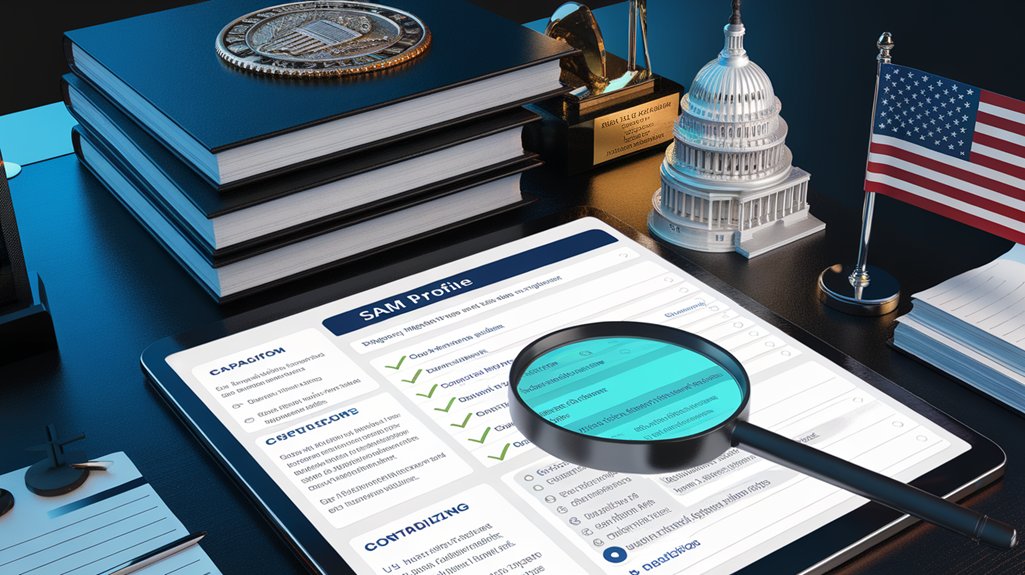A winning SAM profile requires seven critical elements: accurate entity information aligned with legal documentation, strategic NAICS code selection, a compelling capability statement, optimized small business certifications, documented past performance, integrated financial systems for payment processing, and proactive maintenance procedures. Federal buyers prioritize profiles with verified information, relevant industry codes, and proven performance metrics. Agencies seek contractors who maintain current certifications and demonstrate expertise through quantifiable results. The following strategies reveal how to transform your SAM profile into a powerful marketing tool.
Entity Profile Accuracy: Aligning Legal and Physical Documentation

When registering in the System for Award Management (SAM), federal contractors must guarantee precise alignment between their entity profile information and supporting legal documentation.
The entity validation process verifies that legal business names match IRS records exactly and that physical addresses can be confirmed through utility bills or official documents.
Entity validation requires exact name matching with IRS records and address verification through utility bills or official documentation.
Documentation protocols require specific evidence based on company circumstances. Organizations less than five years old must submit articles of organization during validation, while all entities need proof of their current physical location.
When discrepancies arise, SAM’s Entity Validation Service flags the record, triggering an incident that starts a 90-day resolution period.
For companies experiencing multiple data mismatches, a multi-document approach becomes necessary. This may include notarized affidavits when primary documentation is unavailable.
Maintaining consistent naming conventions across all official documents and accounts is critical, as inconsistencies can result in registration delays or denial of contracts.
Setting quarterly review reminders helps ensure your entity information remains accurate and prevents potential validation issues during the federal contracting process.
Maintaining this alignment is essential, as annual recertification requires that all information remains current and verifiable through established documentation standards. Submitting clear scanned copies of all required documents helps prevent unnecessary validation delays and ensures continuous eligibility for federal contracting opportunities.
Strategic NAICS Code Selection for Maximum Visibility

Selecting the right North American Industry Classification System (NAICS) codes forms the cornerstone of effective federal contracting visibility. Companies must align these codes with their core competencies while strategically positioning for relevant opportunities.
Successful contractors conduct thorough competitor analysis to identify which NAICS code classifications are generating awards in their target markets. This research reveals high-opportunity sectors and appropriate benchmarks for code selection.
When implementing NAICS strategy, businesses should:
- Verify size standards for each selected code to guarantee eligibility
- Choose granular 6-digit codes rather than broader categories to reduce competition
- Update code selections biannually to reflect industry changes
- Cross-reference with PSC codes for complete alignment
Maintaining documentation to justify code selections strengthens audit preparedness, while monitoring agency purchasing patterns helps contractors adjust their NAICS portfolio to match evolving federal procurement priorities. NAICS codes also provide a systematic way to categorize business activities based on their primary functions within the North American economy. Understanding that NAICS codes define eligibility criteria for government contracts can significantly impact a company’s success in securing federal business opportunities. Distinguishing between primary NAICS codes that represent your core business and secondary codes that showcase your diversified capabilities can substantially improve marketplace positioning and contract acquisition potential.
Compelling Capability Statement Development

Every effective federal contractor needs a meticulously crafted capability statement that serves as their critical marketing document when pursuing government opportunities. This one-to-two-page document highlights core competencies, past performance, and unique differentiators that set a company apart from competitors.
The capability statement design should be visually impactful while maintaining clarity and relevance to specific government buyers. Our professional design service emphasizes clarity and professionalism in the presentation of your capabilities to government agencies.
Federal contractors should guarantee their capability statements include:
- Corporate information with DUNS and CAGE codes that establish legitimate business credentials
- Clear articulation of core competencies that directly address agency needs
- Compelling past performance examples demonstrating proven success
- Unique differentiators that show why their solution outperforms competitors
- Consistent alignment with SAM profile information for seamless verification
Regular updates to capability statements are essential as companies evolve their service offerings.
When customized for specific solicitations, these documents become powerful tools for building relationships with government decision-makers and securing contracts. Much like successful grant applications, capability statements should incorporate compelling storytelling backed by evidence to effectively communicate your company’s value proposition to federal agencies.
Small Business Certification Optimization

Small business certification represents a cornerstone of federal contracting success, building upon the foundation established through capability statements. Proper optimization of certification details in both SAM.gov and DSBS systems dramatically increases visibility to federal buyers.
Effective certification strategies require:
- Self-certification through SAM.gov with accurate NAICS/PSC codes
- Cross-platform keyword alignment between SAM and DSBS profiles
- Regular updates to prevent certification expirations
- Strategic selection of NAICS codes with high set-aside activity
Profile enhancements should include targeted keyword placement that balances federal acquisition terminology with specific capabilities. Research shows 70% of small business profiles fail visibility benchmarks without optimization. Tailored packages can significantly improve your chances of standing out in the crowded federal marketplace.
While registration itself carries no government fee, businesses may consider third-party assistance for DSBS profile optimization, typically starting at $800. Registration in the System for Award Management makes businesses eligible for set-asides specifically designated for qualified small businesses.
Maintain compliance through quarterly audits of UEI, tax ID, and CAGE code validity to avoid potential False Claims Act liability for misrepresentation. Women-owned small businesses should apply through certify.sba.gov to demonstrate at least 51% women ownership and meet management criteria for certification eligibility.
Past Performance Showcasing for Credibility Building

Federal buyers rely heavily on past performance documentation when evaluating potential contractors, making it a critical component of SAM profile development. After conducting keyword searches, buyers carefully examine capability narratives to identify businesses with relevant expertise. Effective project selection and narrative presentation transform standard profiles into compelling demonstrations of capability. Contractors should prioritize relevant projects that showcase diversity and complexity management while incorporating quantifiable metrics that demonstrate value delivered. Regular updates to your performance history ensure contracting officers can see your most recent successes. Maintaining grant compliance standards within your profile is essential for organizations seeking both contract and grant opportunities from federal sources.
- Detailed success stories that demonstrate how your company overcame significant challenges
- Client testimonials that validate your claims and establish trust with potential buyers
- Metrics-driven results showing precise budget savings and timeline adherence
- Award recognition highlighting industry acknowledgment of excellence
- Problem-solving examples showcasing innovative approaches to complex requirements
Maintaining alignment between SAM profiles and CPARS evaluations further strengthens credibility. Contractors should regularly update performance data, ensuring information remains current and accurately reflects growing capabilities.
Strategic presentation of past performance creates a competitive advantage by building confidence in a contractor’s ability to deliver consistently.
Financial System Integration for Seamless Payments

While operating within the federal marketplace, contractors must establish robust financial system integrations to guarantee timely and accurate payment processing.
Companies that implement digital payment integration solutions can notably reduce wait times traditionally associated with government transactions.
Vendors should prioritize automated accounting systems that seamlessly connect with government procurement platforms like PRISM. These integrations assure compliance with Federal Acquisition Regulations (FAR) while simplifying transaction processing. Leveraging the PIEE platform can further streamline procurement processes by providing centralized access to payment systems and data.
Businesses already accepting major credit cards will find GSA SmartPay integration particularly straightforward.
Modern payment systems provide financial analytics capabilities that enable better decision-making and resource allocation for both vendors and government agencies.
Professional services can help contractors navigate the complex registration requirements when setting up their financial systems for federal payment processing.
Key benefits include:
- Enhanced efficiency through streamlined payment workflows
- Improved transaction security and data protection
- Automatic cloud storage of procurement records
- Reduced manual errors in financial reporting
- Better visibility within federal procurement networks
Proactive Maintenance and Renewal Management

The maintenance of a SAM profile represents a critical, ongoing responsibility for contractors seeking sustained success in the federal marketplace. Regular profile updates prevent disruptions in eligibility and guarantee compliance with changing federal requirements.
Companies should implement a structured approach to SAM renewal, beginning the process at least 90 days before expiration to address potential issues without rushing. The SAM.gov portal sends email notifications to remind users when their registration is approaching expiration. Failing to renew your SAM registration on time can result in a temporary ineligibility to bid on new federal contracts or receive payments on existing ones.
- Fear of missed opportunities when outdated profiles exclude businesses from contract consideration
- Stress of last-minute renewals that may contain errors or omissions
- Confidence in presenting accurate capabilities to federal procurement officers
- Relief of maintaining continuous eligibility for federal contracts
- Anxiety reduction through organized documentation and renewal reminders
Setting calendar renewal reminders and conducting quarterly profile reviews helps maintain accuracy.
Designating trained staff members responsible for SAM management guarantees consistent attention to this crucial business asset. Proper maintenance directly correlates with increased visibility to federal buyers and contract award potential.
Frequently Asked Questions
How Quickly Can Agencies View Profile Updates After Submission?
Profile updates submitted to SAM.gov are not immediately visible to agencies.
Standard updates typically take 3 business days to process, while complex changes requiring additional validation may extend to 10 business days. During this processing period, agencies cannot view the new information.
SAM.gov exports updated data to government contracting systems nightly after approval, and registrants should verify completion via their SAM dashboard before expecting agency review of their modified profile information.
Which SAM Profile Elements Are Visible to Competitors Versus Agencies?
SAM profile transparency varies considerably between competitors and agencies.
Competitors can view basic registration details, NAICS codes, past performance, contact information, and business size status.
Agencies have exclusive access to certification validations, capability narratives, financial information, GSA contract numbers, and subcontracting plans.
This differential competitor visibility protects sensitive business information while allowing government buyers to conduct thorough vendor evaluations.
Some elements, such as teaming relationships and geographic service areas, can be inferred from publicly available contract data.
Can Subcontractors Win Federal Work Without a SAM Registration?
Yes, subcontractors can win federal work without SAM registration.
As of 2024, subcontractor eligibility for federal projects requires only a Unique Entity Identifier (UEI), not full SAM registration.
Prime contractors, who maintain federal compliance through their own SAM registration, bear responsibility for government interactions.
Subcontractors can obtain UEIs through self-registration (taking 2-3 months) or assisted services (4-6 weeks).
This arrangement allows businesses to participate in federal contracting while avoiding the full registration process.
How Do Teaming Agreements Appear in SAM Profiles?
Teaming agreements themselves don’t directly appear in SAM profiles.
Instead, companies implement teaming strategies by listing relevant capabilities and past performance that reflect their collaborative arrangements.
While the formal teaming documentation remains separate from SAM, contractors can enhance profile visibility by accurately describing expanded capabilities resulting from partnerships.
Companies should guarantee their NAICS codes and capability statements reflect the combined strengths that teaming agreements provide when pursuing federal opportunities.
What Are the Consequences of Misrepresenting Socioeconomic Status?
Misrepresenting socioeconomic status in federal contracting carries severe legal repercussions.
Violators face penalties under the False Claims Act, including liability for the entire contract value, suspension, and debarment from federal contracting.
The socioeconomic impact extends to financial losses, damaged reputation, and lost future opportunities.
Businesses must repay misappropriated awards and may incur substantial legal costs to defend against allegations, while facing potential civil and criminal penalties.